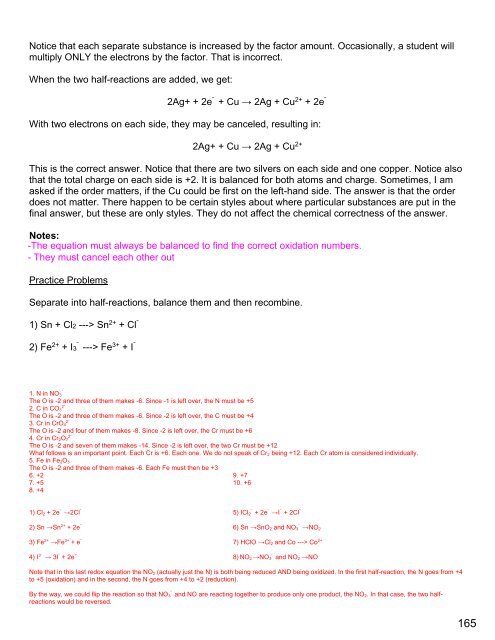Create successful ePaper yourself
Turn your PDF publications into a flip-book with our unique Google optimized e-Paper software.
Notice that each separate substance is increased by the factor amount. Occasionally, a student will<br />
multiply ONLY the electrons by the factor. That is incorrect.<br />
When the two half-reactions are added, we get:<br />
2Ag+ + 2e¯ + Cu → 2Ag + Cu 2+ + 2e¯<br />
With two electrons on each side, they may be canceled, resulting in:<br />
2Ag+ + Cu → 2Ag + Cu 2+<br />
This is the correct answer. Notice that there are two silvers on each side and one copper. Notice also<br />
that the total charge on each side is +2. It is balanced for both atoms and charge. Sometimes, I am<br />
asked if the order matters, if the Cu could be first on the left-hand side. The answer is that the order<br />
does not matter. There happen to be certain styles about where particular substances are put in the<br />
final answer, but these are only styles. They do not affect the chemical correctness of the answer.<br />
Notes:<br />
-The equation must always be balanced to find the correct oxidation numbers.<br />
- They must cancel each other out<br />
Practice Problems<br />
Separate into half-reactions, balance them and then recombine.<br />
1) Sn + Cl2 ---> Sn 2+ + Cl¯<br />
2) Fe 2+ + I3¯ ---> Fe 3+ + I¯<br />
1. N in NO 3¯<br />
The O is -2 and three of them makes -6. Since -1 is left over, the N must be +5<br />
2. C in CO 3<br />
2¯<br />
The O is -2 and three of them makes -6. Since -2 is left over, the C must be +4<br />
3. Cr in CrO 4<br />
2¯<br />
The O is -2 and four of them makes -8. Since -2 is left over, the Cr must be +6<br />
4. Cr in Cr 2 O 7<br />
2¯<br />
The O is -2 and seven of them makes -14. Since -2 is left over, the two Cr must be +12<br />
What follows is an important point. Each Cr is +6. Each one. We do not speak of Cr 2 being +12. Each Cr atom is considered individually.<br />
5. Fe in Fe 2 O 3<br />
The O is -2 and three of them makes -6. Each Fe must then be +3<br />
6. +2 9. +7<br />
7. +5 10. +6<br />
8. +4<br />
1) Cl 2 + 2e¯ →2Cl¯ 5) ICl 2¯<br />
+ 2e¯ →I¯ + 2Cl¯<br />
2) Sn →Sn 2+ + 2e¯ 6) Sn →SnO 2 and NO 3¯<br />
→NO 2<br />
3) Fe 2+ →Fe 3+ + e¯ 7) HClO →Cl 2 and Co ---> Co 2+<br />
4) I 3¯ → 3I¯ + 2e¯ 8) NO 2 →NO 3¯<br />
and NO 2 →NO<br />
Note that in this last redox equation the NO 2 (actually just the N) is both being reduced AND being oxidized. In the first half-reaction, the N goes from +4<br />
to +5 (oxidation) and in the second, the N goes from +4 to +2 (reduction).<br />
By the way, we could flip the reaction so that NO 3¯<br />
and NO are reacting together to produce only one product, the NO 2 . In that case, the two halfreactions<br />
would be reversed.<br />
165



